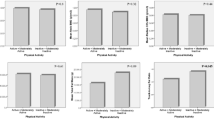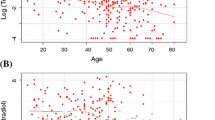Abstract:
Osteoporosis in men is a significant health problem, and factors associated with bone mass are being investigated. Although osteoporosis is a typical feature of hypogonadism, the influence of testosterone levels and other hormonal factors on bone mass of eugonadal males is unknown. Our aim was to identify several anthropometric and hormonal predictors that could be responsible for the variability in bone mineral density (BMD) in healthy men. One hundred elderly men (age 68 ± 7 years) were investigated in this cross-sectional study. BMD was measured by dual-energy X-ray absorptiometry (DXA) at the lumbar spine and femoral sites (femoral neck, Ward’s triangle, trochanter, intertrochanter and total femur). Anthropometric measures were obtained including: weight, height, body mass index (BMI), waist–hip ratio and testicular volume. Hormonal data measures were total, free and bioavailable testosterone, dihidrotestosterone, estradiol, sex hormone binding globulin (SHBG), insulin-like growth factor I (IGF-I), intact parathyroid hormone (iPTH) and 1,25-dihydroxyvitamin D3 (1,25(OH)2D3). One subject was excluded because primary hypogonadism was found. SHBG levels were increased in 53.5% of men, and 8% showed a mild increase in iPTH levels. Twenty-eight subjects had densitometric criteria of osteoporosis (T-score ≤−2.5). All BMD sites were positively correlated with body weight (r= 0.29–0.48, p<0.001) and BMI (r= 0.24–0.47, p<0.001). A negative correlation between SHBG levels and intertrochanter (IT) and total femur (TL) BMD was found (r=−0.24 and r=−0.22, p<0.05). After adjusting for age and BMI, SHBG and IGF-I levels were negatively correlated (r=−0.33, p<0.001). In multiple linear regression analysis independent predictors of bone mass were body weight, SHBG and iPTH levels. The best predictive model accounted for 24–40% of the observed variability of BMD. However, most of the BMD variability was explained by body weight. In conclusion, in our study body weight, SHBG and iPTH levels were predictors of BMD in healthy elderly men.
Similar content being viewed by others
Author information
Authors and Affiliations
Additional information
Received: 9 June 2000 / Accepted: 27 September 2000
Rights and permissions
About this article
Cite this article
Martínez Díaz-Guerra, G., Hawkins, F., Rapado, A. et al. Hormonal and Anthropometric Predictors of Bone Mass in Healthy Elderly Men: Major Effect of Sex Hormone Binding Globulin, Parathyroid Hormone and Body Weight . Osteoporos Int 12, 178–184 (2001). https://doi.org/10.1007/s001980170127
Issue Date:
DOI: https://doi.org/10.1007/s001980170127




